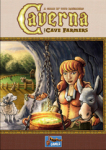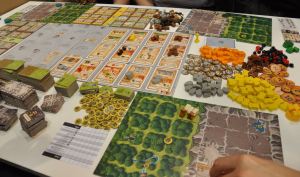Unplugged – Caverna: The Cave Farmers (Boardgame)
 Caverna: The Cave Farmers
Caverna: The Cave Farmers
Designer: Uwe Rosenberg
Publisher: Mayfair Games (in the US)
Ages: 12+
Players: 1-7
Time: 120 mins
(Review copy provided by Mayfair Games)
Videogaming has its rockstar designers like Sid Meier, John Romero, and Shigeru Miyamoto. Boardgaming has its own list of elite designers and Uwe Rosenberg is among them. Best known for two games, the popular family game, Bohnanza, and his deeper strategy game, Agricola. Agricola is ranked the fourth most popular boardgame at BoardGameGeek.com even though it released seven years ago. Rosenberg has produced a few titles since Agricola, but his newest, Caverna, returns to many of the mechanics and themes of Agricola. While it doesn’t quite reach the heights of gaming seen in Agricola, Caverna is a solid title and may be a better choice for those looking for a title where a player can make mistakes and still be able to bounce back.
Like Agricola (and many other games), Caverna: The Cave Farmers is a worker-placement game. This means each player begins with workers (three dwarves in this case). Players take turns putting their workers onto the board and gain different benefits for being placed in different areas. Once all the workers of all the players are placed, the workers are returned and a new round begins again. In Caverna, players place workers to acquire food, expand their farms, expand their cave dwelling, go on expeditions, and expand their families. Expanding families allows a player to gain more dwarves (workers) and thus gain more actions each round. This is common in worker-placement games and is often one of the more important actions one can take.
Players use a personal board to keep track of their own homestead. They must first “clear out” their forest to make meadows or their mountain to make caves. Once a forest or cave is cleared out, players can then use resources to build up up those spaces into more valuable (and useful) locations. Examples include pastures for animals or mines to acquire more rare resources.
An entire game of Caverna is only 12 rounds, so players must carefully plan ahead for each of their action choices. At the end of each round, one’s dwarves must be fed so there is an immediate need to quickly develop an ongoing way to feed one’s workers. This can be accomplished by developing fields, putting animals into pastures, or going on expeditions. Once a source of food is set up, players can begin trying to build up their farms, houses, and caves to be worth gold at the end of the game. Almost anything a player pursues is worth gold, and the player with the most gold points wins the game. While players can often specialize (often by focusing on farming or on arming their dwarves for expeditions), it pays to be a slight generalist. Players will lose a few points for any missing types of farm animals or unused spaces on their housing/building board.
The heart of the game lies in planning ahead for the future by clearing out spaces and purchasing developments that will interact to provide a player with many resources (and gold points) at the end of the game. The game provides a tense sense of urgency because players must also attend to the near term by supplying food to their workers at the end of nearly every round.
Caverna may seem like a complex game to players new to this style of strategic boardgame. However, if players are willing to give it a try, they will get the hang of how things work about halfway through the game. That may be more effort than some are willing to make, but for others it will reward them with a replayable game rich in strategic choices. Personally, I prefer Agricola over Caverna due to Agricola’s special starting conditions. In Agricola, players get a unique set of starting cards dealt to them, giving everyone a unique starting position. However, because Caverna lacks that aspect of the game, it is easier for new players to pick up and play. The game can be played solo as a puzzle and goes up to 7 players at once, although gamers would need to be very fast or at least dedicated to playing together with 7 players or gamers will notice long waiting periods between turns. The game is heavy as a rock, due to the large number of wooden pieces and player boards, and is thus quite expensive (almost $100 MSRP, but you can find it slightly cheaper). This is about the price of a couple of new-release videogames, but if the game is enjoyed enough to get repeated plays, it would end up a better value. If nothing else, its resale value will remain vastly better than a pair of aging videogames.
Kid Factor: This is a complex game. The actual mechanics of the game are not too hard – I’ve played Agricola with my 2nd grade son, but to do well at the game requires planning at a level appropriate for most pre-teens. Technically, because everything in the game is open information, a gamer wouldn’t even need to be able to read to play the game since another player can explain the options available. One nice feature of this style of game (and Caverna in particular) is that it is non-confrontational. Players vie for limited resources, but since each player is looking after their own farms and caves, there is very little opportunity for direct aggression. This makes the game appropriate for those families where sibling rivalry may be a bit more heated.






Discussion Area - Leave a Comment